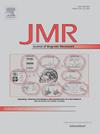Cryogenic field-cycling instrument for optical NMR hyperpolarization studies
IF 1.9
3区 化学
Q3 BIOCHEMICAL RESEARCH METHODS
引用次数: 0
Abstract
Optical dynamic nuclear polarization (DNP) offers an attractive approach to enhancing the sensitivity of nuclear magnetic resonance (NMR) spectroscopy. Efficient, optically-generated electron polarization can be leveraged to operate across a broad range of temperatures and magnetic fields, making it particularly appealing for applications requiring high DNP efficiency or spatial resolution. While a large class of systems hold promise for optical DNP, many candidates display both variable electron polarizability and electron and nuclear T1 relaxation times as functions of magnetic field and temperature. This necessitates tools capable of studying DNP under diverse experimental conditions. To address this, we introduce a cryogenic field cycling instrument that facilitates optical DNP studies across a wide range of magnetic fields (10 mT–9.4 T) and temperatures (∼10 K–300 K) for wide-bore magnets. Continuous cryogen replenishment enables sustained, long-term operation. Additionally, the system supports the ability to manipulate and probe rapidly hyperpolarized (∼60 s) nuclear spins via pulse sequences involving millions of RF pulses. We describe innovations in the device design and demonstrate its operation on a model system of 13C nuclear spins in diamond polarized through optically pumped nitrogen vacancy (NV) centers. We anticipate the use of the instrument for a broad range of optical DNP systems and studies.

用于光学核磁共振超极化研究的低温场循环仪器
光学动态核极化(DNP)是提高核磁共振(NMR)光谱灵敏度的一种有吸引力的方法。利用高效的光学产生的电子极化可以在广泛的温度和磁场范围内工作,这使得它对需要高DNP效率或空间分辨率的应用特别有吸引力。虽然一大类系统有望实现光学DNP,但许多候选系统显示出可变的电子极化率以及电子和核T1弛豫时间作为磁场和温度的函数。这就需要能够在不同实验条件下研究DNP的工具。为了解决这个问题,我们引入了一种低温场循环仪器,该仪器有助于在宽口径磁体的大范围磁场(10 mT-9.4 T)和温度(~ 10 K - 300 K)下进行光学DNP研究。持续的冷冻剂补充可以保证持续、长期的运行。此外,该系统支持通过涉及数百万RF脉冲的脉冲序列操纵和探测快速超极化(~ 60秒)核自旋的能力。我们描述了器件设计上的创新,并在一个通过光泵浦氮空位中心偏振的金刚石13C核自旋模型系统上演示了其操作。我们期望将该仪器用于广泛的光学DNP系统和研究。
本文章由计算机程序翻译,如有差异,请以英文原文为准。
求助全文
约1分钟内获得全文
求助全文
来源期刊
CiteScore
3.80
自引率
13.60%
发文量
150
审稿时长
69 days
期刊介绍:
The Journal of Magnetic Resonance presents original technical and scientific papers in all aspects of magnetic resonance, including nuclear magnetic resonance spectroscopy (NMR) of solids and liquids, electron spin/paramagnetic resonance (EPR), in vivo magnetic resonance imaging (MRI) and spectroscopy (MRS), nuclear quadrupole resonance (NQR) and magnetic resonance phenomena at nearly zero fields or in combination with optics. The Journal''s main aims include deepening the physical principles underlying all these spectroscopies, publishing significant theoretical and experimental results leading to spectral and spatial progress in these areas, and opening new MR-based applications in chemistry, biology and medicine. The Journal also seeks descriptions of novel apparatuses, new experimental protocols, and new procedures of data analysis and interpretation - including computational and quantum-mechanical methods - capable of advancing MR spectroscopy and imaging.

 求助内容:
求助内容: 应助结果提醒方式:
应助结果提醒方式:


